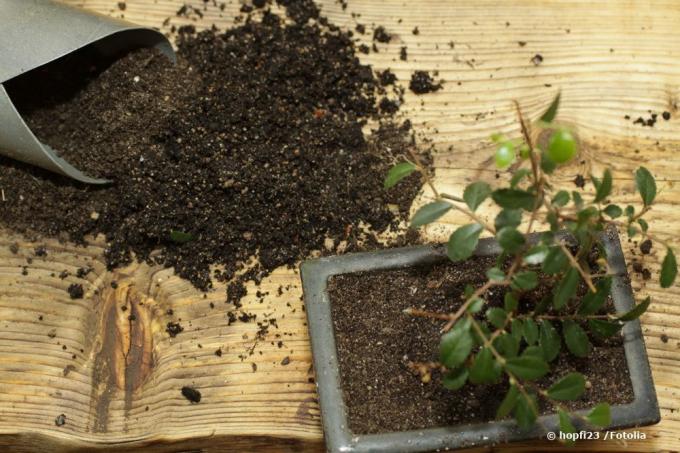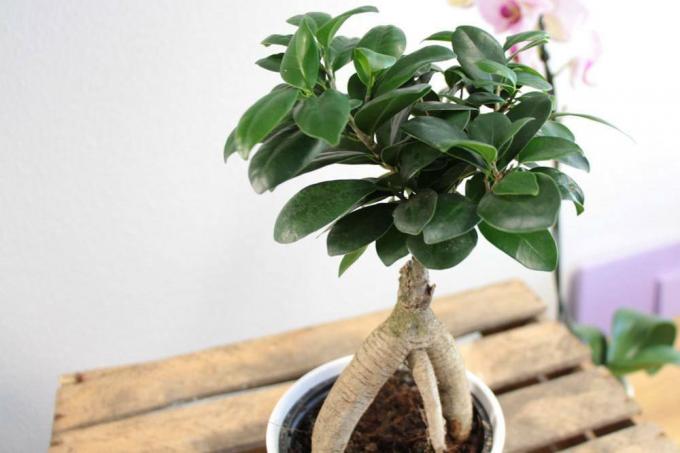
table of contents
- Causes and Actions
- dryness
- Waterlogging
- light
- Incorrect humidity in winter
- Wrong substrate
- Wrong pot size
- Overfertilization
- Change of location
- Drafts
- Unproblematic: seasonal leaf loss
With their artistic growth and small size, bonsai are one of the most important aspects of Far Eastern, or more precisely Japanese, garden art. Due to their small growth habit, kept in equally small containers, they require a lot of care, regardless of whether it is an indoor or outdoor bonsai. If the plant is losing yellow or even green leaves, there is usually a problem that you absolutely need to address so that the ornate dwarf does not die completely.
Causes and Actions
dryness
Drought is a big problem for many bonsai trees as they have little substrate available. Depending on the type of bonsai, the plant reacts to prolonged drought with the loss of green or yellow leaves. Especially in specimens in which the roots protrude from the shell together with the substrate, a lack of water is often the cause of leaf loss. The following solution is available here:
- if the substrate is solid, dip the entire bowl
- Leave it in the immersion bath until no more air bubbles rise
- then drain well
- do this once or twice a week
- daily in summer, but less often in winter
- Do not dive in loose soil
- just spray the root ball with plenty of water
- Keep spraying until the water comes out of the drainage holes
- this process sometimes needs to be done every day, except in winter
- water as soon as the substrate has dried slightly
Waterlogging
A bonsai, regardless of whether it is Ficus ginseng, Pines or penny trees, in most cases they lose their foliage when waterlogged. Too much moisture leads to Lazy of the roots, which in turn causes the loss of green foliage. If your plant gets too much water, you must act immediately and repot:
- carefully remove the plant from the pot
- detach the soil from the roots with a sure instinct
- Use disinfected or clean scissors to thoroughly cut off rotten roots
- feel fresh substrate in the bowl
- use only high quality bonsai substrate for this
- put the plant in the fresh substrate
- then do not water for the next four days, then water only if necessary
That Repot is the only way you can protect your bonsai from waterlogging, as the roots rot quickly and can no longer regulate the distribution of nutrients. Yellow leaves are seldom a cause of waterlogging and are heavily dependent on the respective tree species.

tip: it can happen that further leaf loss occurs after repotting, because some species are sensitive to the root cut. However, you usually don't have to worry about it as long as the dwarf has been given fresh substrate and dry roots.
light
Typical for the dwarfs is the high light requirement, as it is still with them real trees acts. The plant loses foliage when insufficient light is available, which is mainly reflected in the loss of a large amount on one side of the tree. This is usually the side facing the window, when the sun can shine on the bonsai with all its strength during midday or early afternoon. Yes, a bonsai tree needs a lot of light, but no direct sunlight at the warmest time of the day. The plant burns in the sun, so to speak. The following measures will help:
- change location so that it is not in direct sunlight
- alternatively, hang up a curtain or sun protection
- the dwarfs only need a few hours of pure sunlight in the evening or morning
If the bonsai loses pale green and yellow leaves, it is too dark. In this case he drives so-called Shoots of light looking for more light, which significantly weakens the plant over time. Only one thing helps here Change of location with more light. In addition, you have to cut off the light shoots directly on the trunk so that they no longer steal energy from the bonsai tree.
Incorrect humidity in winter
Do you keep your bonsai over the heater over the winter? Dry heating air and low humidity are a big problem for the crop and the Leaf loss is just one of the consequences of the constant heating of the root ball and substrate develop. Here it is no longer enough to water the plant sufficiently, just one Change of location. Choose a cooler room, such as a bedroom or guest room, with windows facing east or west. This gives the tree enough light and warmth, but does not suffer from dry heat. Don't forget to spray and water, of course.
tip: If the loss of leaves is already well advanced, you can pack the plant in a transparent plastic bag, as this regulates the humidity quickly and effectively. This method is not limited to winter and can be used all year round to protect the sapling from stress.
Wrong substrate
In most cases, many bonsai beginners do not change the substrate in which the plant is after purchase. However, in many cases it is a wrong, heavily clayey soil that is not suitable for the crops and leads to leaf loss or other problems. Repotting in fresh bonsai soil is the only solution here.
Wrong pot size
The following applies to bonsai: the roots need space corresponding to the size of the crown. That is, the larger the crown, the larger the shell needs to be. If your bonsai looks healthy but is losing leaves, you should carefully lift the plant out of the pot and check the roots. If fine roots can be seen on the outside of the substrate, you need a larger bowl. Get a new bowl that offers enough space and repot the plant.
Overfertilization
Over-fertilization can happen quickly due to the size of the pot and causes yellow leaves to plague the plant, and they can also fall off. The reason for this is too high a content of salts that accumulate in the earth. Species like Ficus Ginseng in particular first develop yellow foliage before losing it. You can solve the problem as follows:
- if the substrate is solid, immerse the bucket in water
- this allows the fertilizer to spread better and excess fertilizer is flushed out
- If the substrate is loose, you definitely have to repot
- Likewise, if the bonsai has already lost a lot of leaves, which indicates massive over-fertilization
- Make sure to clean the bowl before filling with fresh soil
- this will avoid possible accumulations of fertilizer
- then put the plant in the fresh substrate and do not fertilize immediately
Change of location
If your bonsai suddenly loses green leaves, it may very well be related to a change of location. Since the plants are a special form of keeping, they are very sensitive to change their location, even if it is not ideal for them. Especially in the first few days, the change can stress the plant, so you should give the plant some time in a new location in the event of a sudden loss of leaves. In most cases, the sapling will recover as long as you do not immediately choose another location. The less the plant moves, the better.
Drafts
Drafts usually do not harm bonsai outdoors. However, specimens in your living space should not be exposed to drafts, especially not in winter. This can create an imbalance in heat and lead to leaf loss of the green foliage. So make sure you choose a suitable location without exposing the plant to additional stress, as described above under the change of location.
Unproblematic: seasonal leaf loss
There is another form of leaf loss in which yellow, green, and even red leaves fall off the bonsai. Many people forget that bonsai trees are real trees in small format. For this reason, the natural course of the year leads to a loss of leaves, as is the case with deciduous trees and some conifers. While a Ficus Ginseng should not lose leaves, the fall of leaf loss in the majority of deciduous trees is within the temperate climate zone, such as the elms (bot. Ulmus), predetermined. However, the following conifers can also suffer from leaf loss:
- Primeval sequoia tree (bot. Metasequoia)
- Larches (bot. Larix)
- Golden larch (bot. Pseudolaris)
Compared to the conifers mentioned above, there are other trees that only lose their needles after two to three years:
- White pine (bot. Pinus strobus)
- Scots pine (bot. Pinus sylvestris)
- Spruce (bot. Picea)

A black pine (bot. Pinus nigra), on the other hand, only loses its needles after three to eight years. Be sure to find out what kind of tree your bonsai is. This is the only way to make sure that the leaf loss is seasonal and not due to one of the causes mentioned above. For example, if you grow an evergreen juniper as a bonsai in the garden and its green needles are falling off, then there is a bigger problem behind it. Also make sure that deciduous bonsai really lose their foliage in autumn.





